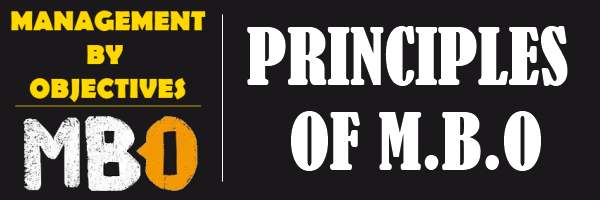Principles of Management by objectives (MBO)

Table of Contents
Management by objectives (M.B.O)
There are so many approaches to integrate individual goals with overall goals. The most comprehensive approach is Management By Objectives (MBO). It is an approach to effective management through achievement of goals. In the management by objectives, the goals and standards are fixed after having discussed with managers at various levels, which secures integration of organizational goals with individual goals. Supreme managers assume responsibilities for performance of subordinates. Subordinates are allowed to exercise self-direction and self-control to a great extent. Management by objectives also provides for extensive participation by all managers in all important matters of the organization. All this provides scope for development of creative abilities of individuals.
Principles of M.B.O. or Steps involved in M.B.O.
Following are the three common principles of management by objectives:
1. Establishment of objectives.
2. Performance.
3. Appraisal of performance based on the objectives.
1. Establishment of Objectives
The establishment of objectives can be studied under the following heads:
1. Hierarchy of Objectives: Organizations have multiple objectives. Objectives have a hierarchy. The objectives achieved on lower levels are the means by which objectives at higher levels are reached. Each level of objective stands as an end relative to the levels below it and as a means relative to the levels above it. This hierarchy of objectives directs the behavior of every member and every department towards the highest objective of the organization that will ensure better understanding of M.B.O.
2. Objectives under M.B.O: Objectives are the ultimate goals towards which an organization’s activities are directed. Objectives should be sound ones. That means it should be measurable, specific, result oriented, realistic, attainable and time bounded. They should be clear and concise and understood by those who want to achieve them. Objectives should be consistent with the organizational policies and procedures. They should be specific enough to be used as standards for control purposes.
Objectives may be quantitative or qualitative. In the higher management structure, objectives tend to be highly qualitative. Objectives may be of long and short range, If planning is to be effective, there must be proper coordination between short range and long range objectives.
According to George Ordiorne, two types of goals must be considered before a successful M.B.O. programme is established. They are departmental goals and personal development goals. Both these goals are to be integrated to achieve the objectives of any enterprise.
3. Clear Goal: Individual and organizational goals should have clarity. If goals are not clarified, confusion will be the outcome. Firstly, clear objectives should be established for managerial positions. The objectives are generally in the form of numerical and bounded statements. Subjective statements are rarely made.
M.B.O. is based on establishing objectives. In management by objectives, objectives are established jointly by the superior and the subordinates. There are two approaches for setting the objectives in management by objectives. They are top-down and bottom-up. The top-down approach provides clear guidelines to the subordinates in framing their own objectives. The bottom-up approach enables participation by subordinates who are to perform the operations. If the objectives are established exclusively top-down or bottom-up, management by objectives cannot be effective. The establishment of objectives must be in both the directions. Planning and communication must flow in both the directions.
2. Performance
In any M.B.O. system, involvement of top management is very much needed. Top management should actively involve itself by enthusing and motivating the employees towards accomplishment of objectives. But involvement of top management to a large extent than the subordinates should not be encouraged. In this context, Reddin says that if the superior dominates the scene, it becomes “Control by Objectives” and not management by objectives.
If the organization has multiple objectives, there is a possibility of giving importance to a single objective and neglecting the others. To remove this handicap, systems approach is to be adopted so that the balanced set of objectives can be ensured.
Managers should be efficient and well trained so that they can operate management by objectives successfully. If they are not efficient enough to operate management by objectives successfully, they should secure the staff support at least in the initial stages.
3. Appraisal of Performance
The third step involved in M.B.O. is appraisal of managerial performance on the basis of the objectives established beforehand. Performance appraisal is made at the end of a period to evaluate the work. The work of subordinates are evaluated by the superiors with a view to find out deviations, if any. This will enable the management to take corrective measures in case of deviations in performance.
